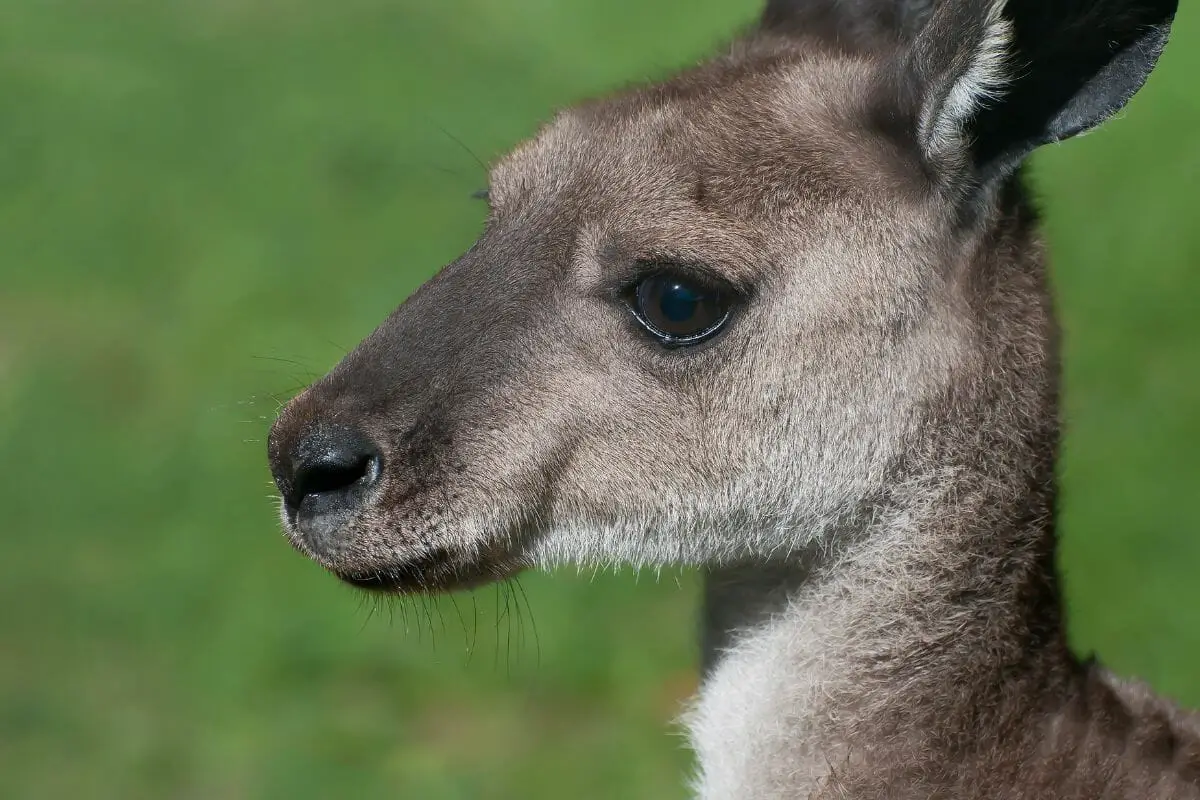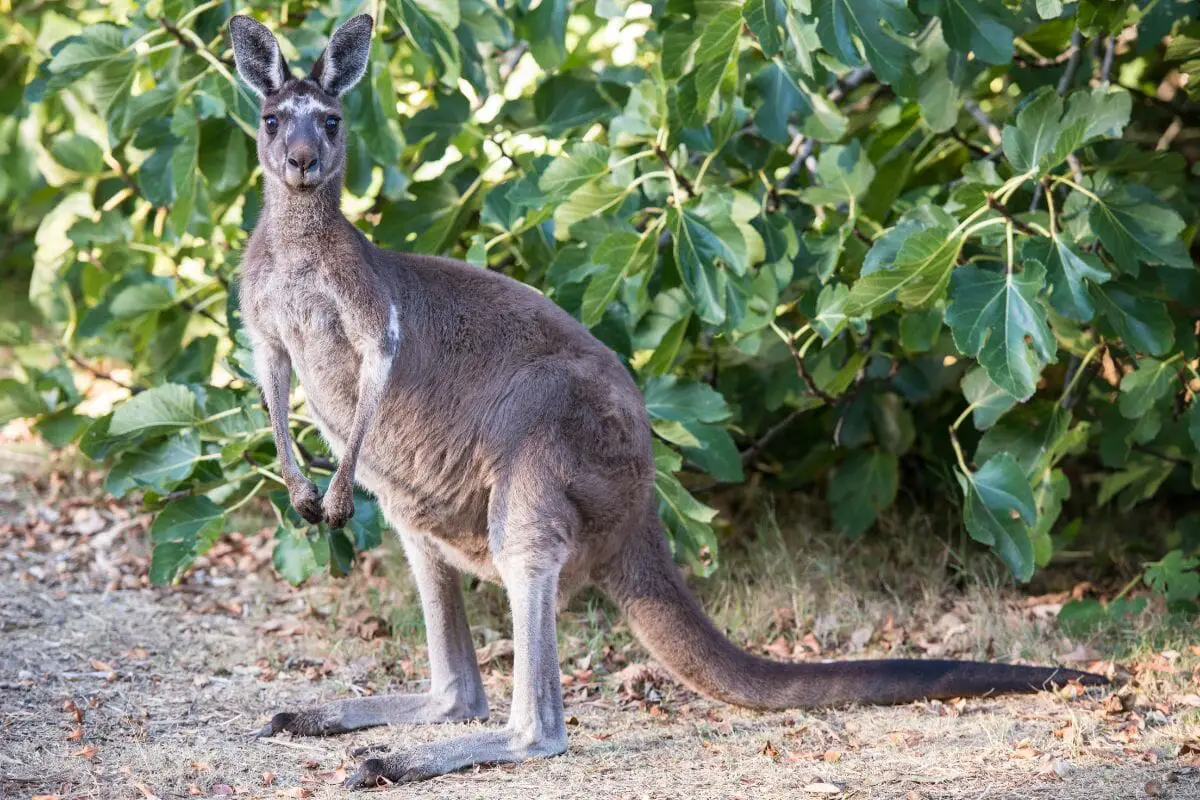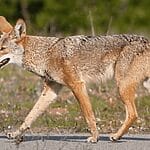Despite widespread imagery of the kangaroo as a friendly, almost fantasy-like creature, it is important to remember that they are still wild animals, and that they, like humans, are prone to certain behavioral traits that are not entirely within their control.

Just with the famed red kangaroo, the Western Gray has their own specific personalities that have come to characterize them, and are worth knowing – especially if you live in close proximity to their natural habitat, or if you are a curious tourist looking to get up close and personal.
So what exactly are the behavioral traits of the Western Gray kangaroo, and can they be aggressive?
The Behaviors Of The Western Gray
Also known as the Western Gray Giant Kangaroo, the Black-Faced Kangaroo, and the Mallee Kangaroo, the Western Gray is a commonly found species all throughout southern Australia – encompassing much of the country’s lowermost regions.
Diet
The Western Gray feeds primarily during the nighttime, when the weather is cool enough for them to be out and foraging for food.
When they eat, they tend to consume small leafy shrubs and grasses – all of which are rife and fertile in their southerly Australian habitat.
This has led to the name ‘stinkers’ or ‘boomers’ being applied to the large males of the species, whose diets have led them to develop a distinct, strong-smelling curry-like odor that has become synonymous with the species.
Reproduction
Generally speaking, the sexual maturity of kangaroos happens at specific ages, with the females of the species usually maturing around 17 months, and males at around 20 months.
Usually living in groups of up to 15 kangaroos, the Western Grays follow behavioral patterns similarly to many other species – namely involving the males of the species competing with one another for the attention of the females within the group.
Once this competition has decided who the dominant male is, they are usually the only kangaroo in the group who has the privilege of mating.
Once fertilization has occurred, the gestation period usually lasts for around 30-31 days, after which the undeveloped fetus miraculously attaches itself to the teat within the female’s pouch, where it will remain for a period of 130-150 days.
Temperament
As a rule, the Western Gray kangaroo is placid and easygoing, however if threatened, they can become aggressive towards humans – although this is generally rare.
When this does happen, the males respond like wild animals of any species – squaring up and protecting their brood from potential predators, intruders, and threats.
This behavior is perfectly normal, and is neither overly aggressive, or unusual.
Generally speaking though, they tend to be fairly agreeable creatures, and have a calm temperament when given the proper distance, and shown the appropriate level of respect.
Are Western Grays Aggressive?
As stated previously, Western Gray males tend to be aggressive during key mating seasons, and when they are provoked or threatened by humans or potential predators, but as a rule the species tends to be placid, calm, and generally easygoing.
They are however often misconstrued as being more aggressive or threatening than they actually are.
This could be a result of many different things, ranging from their large size (7.3 feet long in males), musculature, their fast movements, and even internet videos featuring humans fighting wild kangaroos that continue to do the rounds.
Where Do Western Gray Kangaroos Live?
As we mentioned earlier, Western Grays can be found throughout southern Australia, ranging from the western point of the country’s coastline, up to nearly the most easterly tip.
However, when it comes to their actual habitat, they can be found in the forests, savannah, grasslands, and shrublands throughout this region.
With the migration and development of human civilization within Australia, Western Gray kangaroos are also common sights on golf courses, crop fields, and pastures – where they can sometimes prove a nuisance to agriculture.

What Is Their Lifestyle?
Western Gray kangaroos live a crepuscular lifestyle, which means they sleep during the majority of the daytime, and go about their business during the late evening and the nighttime.
This is because the Australian climate is too intense during the peak hours (mid morning to mid evening), which means that they need to sleep during this period if they are to preserve energy and maintain a healthy weight.
To remain cool, they also use their tongues to lick their forearms, as well as panting (like a dog) to help them reach a comfortable temperature.
They also have the ability to sweat, which generally occurs during physical exertion, and they can vary the volume of their vascular system to help maintain the function of their hearts.
Traveling in groups of 15 or 16 known as ‘mobs’, kangaroos will often seek out shady areas to rest in during periods of extreme heat, allowing the members of the group – predominantly females and Joeys – to conserve their strength and protect themselves from the midday sun.
They also have the ability to swim, something they will engage in if the weather becomes too much to bear, or if they find themselves beset by predators.
What Predators Do Kangaroos Have?
One of their main predators is the dingo – pack animals that can easily outnumber and outfight lone kangaroos, or those whose numbers are not sufficient to defend themselves.
Other predators to Western Grays are wedge-tailed eagles, which generally hunt young kangaroos that stray away from their mothers.
However, the sheer size, strength, and ferocity of this bird means that, when push comes to shove, they can take down fully grown kangaroos with moderate effort.
Of course, one of the main threats to Western Grays are human beings who, namely through hunting, poaching, or culling, can legally kill, skin, and eat kangaroos – assuming they have the proper license.
This is a generally natural occurrence, especially with the rise in confrontation between humans and kangaroos, as agricultural processes move more into rural areas.
Once killed, their hides can be turned into particularly hard wearing leather, and their meat is sold as a delicacy throughout the country and surrounding regions.
Western Grays are also widely considered pests within the agricultural community, namely due to them being a competitor for water supplies and pasture within these areas.
Are Western Grays Endangered?
Western Gray kangaroos are not endangered, and have the official conservation rating of ‘low concern’.
This could be due to any number of things, but is probably due to the high success rate of conception, protections in place to maintain kangaroo populations, and the sheer widespread displacement of the species’ population throughout southern Australia, Tasmania, and places like Kangaroo Island.
Final Thoughts
And there we have it, everything you need to know about the Western Gray kangaroo, and the behavioral traits the species demonstrates.
What is so great about this species is the fact that it remains so prominent throughout the south of Australia, and how even in the face of predators, human culling, and the continual dangers from vehicles and expansion, they continue to thrive and multiply where other species have dwindled.
- 15 Most Common Animals Living In Ponds - 2024-04-23
- What are the Characteristics Of a Wolf – (Characteristics & Interesting Facts) - 2024-04-23
- Animals That Live In The Abyssal Zone - 2024-04-22








